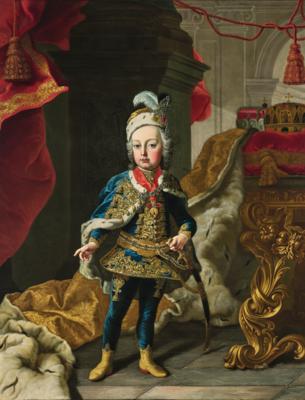Martin van Meytens
(Stockholm 1695–1770 Vienna)
Portrait of Joseph II, Holy Roman Emperor (1741–1790), at a young age,
oil on canvas, 149.5 x 116.5 cm, unframed
Provenance:
sale, Sotheby’s, Monaco, 19 June 1994, lot 441 (as Martin van Meytens and workshop);
Private collection, Belgium
We are grateful to Georg Lechner for endorsing the attribution of the present painting on the basis of a photograph.
Expectations were high for the first born son of Empress Maria Theresia, Joseph II, who is portrayed in the present work. His left hand on his sword and his right nonchalantly pointing in the distance, the prince is captured as a true sovereign aware of his future. The young Joseph is portrayed wearing a deep blue velvet and richly embroidered Hungarian costume, later known as the 'Díszmagyar', consisting of the 'mente', the outer coat, richly lined with ermine, and the 'dolmány', a fitted jacket decorated with braids. The Order of the Golden Fleece completes the costume, a reference to his future appointment as grandmaster of the order in 1765. As his mother was crowned Queen of Hungary in the year of Joseph’s birth, one can presume that she proudly had her heir portrayed in the Hungarian ceremonial fashion. Displayed behind on a red cushion are the Hungarian crown and the archducal coronet, holding the heavy golden imperial mantle elegantly draped around the young prince.
The present painting relates to an unattributed portrait of the same sitter conserved in the Kunsthistorisches Museum, Vienna (inv. no. 7059). The differences between the Vienna work and the present work are the dimensions and the colour of the velvet, which is green in the Vienna painting. A preparatory sketch is preserved in the Albertina, Vienna (inv. no. 39803).
After working in various European cities, Martin van Meytens settled in Vienna around 1730, where he was appointed court painter in 1732. Working mostly as a portrait painter, Meytens portrayed the members of the imperial family and the nobility of Austria, Hungary, Bohemia, and Moravia. His works are characterized by a precise and detailed representation of 18th-century court fashion, showing exquisite details in lacework and embroidery, of which the present painting attests. Besides successfully running his workshop and delivering a vast amount of portraits, Van Meytens was also Director of the Akademie der Bildenden Künste, Vienna (1759) and oversaw significant imperial painting commissions. German art historian and collector Christian Ludwig von Hagedorn (1712–1780) lauded him as the ‘Van Dyck of the present day’.
Esperto: Damian Brenninkmeyer
 Damian Brenninkmeyer
Damian Brenninkmeyer
+43 1 515 60 403
oldmasters@dorotheum.com
24.04.2024 - 18:00
- Prezzo realizzato: **
-
EUR 71.500,-
- Stima:
-
EUR 15.000,- a EUR 25.000,-
Martin van Meytens
(Stockholm 1695–1770 Vienna)
Portrait of Joseph II, Holy Roman Emperor (1741–1790), at a young age,
oil on canvas, 149.5 x 116.5 cm, unframed
Provenance:
sale, Sotheby’s, Monaco, 19 June 1994, lot 441 (as Martin van Meytens and workshop);
Private collection, Belgium
We are grateful to Georg Lechner for endorsing the attribution of the present painting on the basis of a photograph.
Expectations were high for the first born son of Empress Maria Theresia, Joseph II, who is portrayed in the present work. His left hand on his sword and his right nonchalantly pointing in the distance, the prince is captured as a true sovereign aware of his future. The young Joseph is portrayed wearing a deep blue velvet and richly embroidered Hungarian costume, later known as the 'Díszmagyar', consisting of the 'mente', the outer coat, richly lined with ermine, and the 'dolmány', a fitted jacket decorated with braids. The Order of the Golden Fleece completes the costume, a reference to his future appointment as grandmaster of the order in 1765. As his mother was crowned Queen of Hungary in the year of Joseph’s birth, one can presume that she proudly had her heir portrayed in the Hungarian ceremonial fashion. Displayed behind on a red cushion are the Hungarian crown and the archducal coronet, holding the heavy golden imperial mantle elegantly draped around the young prince.
The present painting relates to an unattributed portrait of the same sitter conserved in the Kunsthistorisches Museum, Vienna (inv. no. 7059). The differences between the Vienna work and the present work are the dimensions and the colour of the velvet, which is green in the Vienna painting. A preparatory sketch is preserved in the Albertina, Vienna (inv. no. 39803).
After working in various European cities, Martin van Meytens settled in Vienna around 1730, where he was appointed court painter in 1732. Working mostly as a portrait painter, Meytens portrayed the members of the imperial family and the nobility of Austria, Hungary, Bohemia, and Moravia. His works are characterized by a precise and detailed representation of 18th-century court fashion, showing exquisite details in lacework and embroidery, of which the present painting attests. Besides successfully running his workshop and delivering a vast amount of portraits, Van Meytens was also Director of the Akademie der Bildenden Künste, Vienna (1759) and oversaw significant imperial painting commissions. German art historian and collector Christian Ludwig von Hagedorn (1712–1780) lauded him as the ‘Van Dyck of the present day’.
Esperto: Damian Brenninkmeyer
 Damian Brenninkmeyer
Damian Brenninkmeyer
+43 1 515 60 403
oldmasters@dorotheum.com
|
Hotline dell'acquirente
lun-ven: 10.00 - 17.00
old.masters@dorotheum.at +43 1 515 60 403 |
| Asta: | Dipinti antichi |
| Tipo d'asta: | Asta in sala con Live Bidding |
| Data: | 24.04.2024 - 18:00 |
| Luogo dell'asta: | Wien | Palais Dorotheum |
| Esposizione: | 13.04. - 24.04.2024 |
** Prezzo d'acquisto comprensivo di tassa di vendita e IVA
Non è più possibile effettuare un ordine di acquisto su Internet. L'asta è in preparazione o è già stata eseguita.

